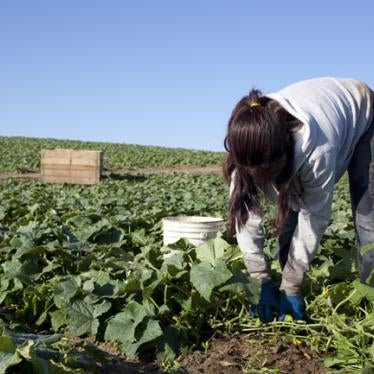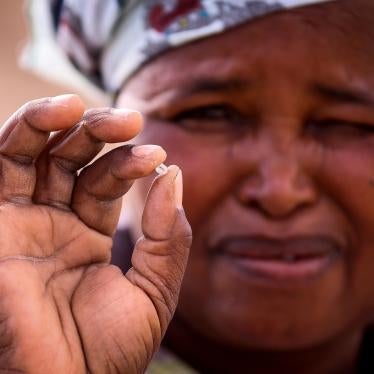Nancy Leppink
Deputy Administrator, Wage and Hour Division
US Department of Labor
200 Constitution Avenue, NW, S-3510
Washington, DC 20210
Re: RIN 1235-AA06 – Proposed Changes to the Agricultural Child Labor Regulations
Dear Deputy Administrator Leppink:
Human Rights Watch strongly supports the proposed amendments to the Agricultural Hazardous Occupations Orders published in the Federal Register on September 2, 2011. Agriculture is the most dangerous industry open to children, according to the Centers for Disease Control’s National Institute for Occupational Safety and Health (NIOSH). The proposed amendments would help protect the youngest child workers from injury and death.
Human Rights Watch has documented the dangerous conditions of work for child farmworkers in the United States since 2000, through firsthand interviews with children, their parents, experts on farm safety and agriculture, and others, as well as through secondary research.[1] Human Rights Watch conducts research on the worst forms of child labor around the world and has reported on hazardous child labor in agriculture in Ecuador, Egypt, El Salvador, India, and Kazakhstan, as well as the United States. We conclude that the US government’s failure to protect children working in agriculture not only endangers children, it also violates the country’s international legal obligations, including under ILO Convention No. 182 on the Worst Forms of Child Labor.
More children die in agriculture than in any other industry. Last year 12 of the 16 children under age 16 who suffered fatal occupational injuries worked in crop production, according to the Bureau of Labor Statistics. Taking into account older children, more than half of all workers under age 18 who died from work-related injuries worked in crop production. By comparison, crop workers made up only 7 percent of workers of all ages who died from work-related injuries in 2010.[2] According to NIOSH, young workers’ “biologic, social, and economic characteristics” cause them “unique and substantial risks for work-related injuries and illnesses.”[3] These characteristics include rapidly growing “organ and musculoskeletal systems, which may make them more likely to be harmed by exposure to hazardous substances or to develop cumulative trauma disorders”; and less experience, training, and knowledge about how to work safely.”[4]
In interviews with Human Rights Watch, child farmworkers described working with heavy machinery, including tractors; falling from ladders; exposure to pesticides and experiencing symptoms consistent with pesticide poisoning; working in extreme heat to the point of dehydration; and “topping” and harvesting tobacco where they risked green tobacco sickness.[5]
Many of the proposed changes would help address these risks for children under age 16. These would include prohibiting the use of all tractors, all powered equipment, and some non-powered equipment; reducing the working height on a ladder from twenty feet to six feet and extending the prohibition to working at any heights on top or sides of buildings and structures; strengthening protections against pesticides and pesticide handling; and prohibiting work in the production and curing of tobacco.The Labor Department should additionally include in its revisions protections for from temperature extremes, such as heat exposure.
The document in the Federal Register also raises questions about the payment of piece rates and prolonged exposure to potentially harmful conditions. Children routinely told Human Rights Watch that they felt pressure to work as quickly as possible, with few breaks, and to keep working even when injured or when sickened by pesticides, heat, tobacco, or illnesses.[6] In our research we found that payment on a piece rate, in addition to resulting in children often earning far less than the minimum wage, increased this pressure, sometimes at the expense of drinking water or cooling down when overheated.
In conclusion, Human Rights Watch welcomes the proposed amendments to the Agricultural Hazardous Occupations Orders. The changes are long overdue, and we urge the Wage and Hour Division to complete and adopt changes to these rules within 30 days.
Sincerely,
Zama Coursen-Neff
Deputy Director, Children’s Rights Division
Human Rights Watch
[1] See Human Rights Watch, Fingers to the Bone: United States Failure to Protect Child Farmworkers, 2000, https://www.hrw.org/reports/2000/06/02/fingers-bone-0; and Human Rights Watch, Fields of Peril: Child Labor in US Agriculture, 2010, https://www.hrw.org/reports/2010/05/05/fields-peril.
[2] Email from Sean Smith, Bureau of Labor Statistics, US Department of Labor, to Human Rights Watch, August 29, 2011 (citing preliminary data for 2010).
[3] National Institute for Occupational Safety and Health (NIOSH), Centers for Disease Control, “Young Worker Safety and Health,” January 13, 2010, http://www.cdc.gov/niosh/topics/youth/ (accessed April 3, 2010).
[4] NIOSH, “NIOSH Alert: Preventing Deaths, Injuries and Illnesses of Young Workers,” no. 2003-128, July 2003, pp. 1-2.
[5] See Human Rights Watch, Fields of Peril.
[6] Ibid., pp. 55-56.







